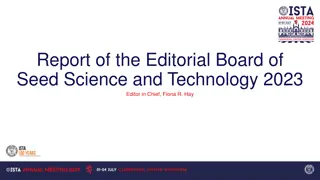Tomato Seed Production and Export Process Overview
This document outlines the comprehensive process involved in the production, harvesting, and post-harvest handling of tomatoes and tomato seeds for export. Starting from pre-production activities like greenhouse registration and soil testing to post-harvest inspections and certification, each stage is meticulously described to ensure high-quality, disease-free tomato products. The protocol covers various steps such as planting, pesticide application, quality control, and packaging to meet international standards. It emphasizes the importance of adherence to regulatory measures and quality assurance practices for successful tomato seed export operations.
Download Presentation

Please find below an Image/Link to download the presentation.
The content on the website is provided AS IS for your information and personal use only. It may not be sold, licensed, or shared on other websites without obtaining consent from the author.If you encounter any issues during the download, it is possible that the publisher has removed the file from their server.
You are allowed to download the files provided on this website for personal or commercial use, subject to the condition that they are used lawfully. All files are the property of their respective owners.
The content on the website is provided AS IS for your information and personal use only. It may not be sold, licensed, or shared on other websites without obtaining consent from the author.
E N D
Presentation Transcript
Dr. Visoni Motofaga Timote (FIJI) Mr. Sitthiphone Phommasak (LAO) Mr. Nasir Ahmad (PAKISTAN) Dr. Nuttima Kositcharoenkul (THAILAND) Ms. Ing-orn Panyakit (THAILAND)
1. Fresh tomatoes for consumption Pre-production 1 Registration green house (annually/ audit by NPPO) 2. Double doors entry 3. Soil testing 4. Soil sanitization 5. Seed treatment 6. Greenhouse sanitation
Production 1. Planting eggplant root stocks 2. Pesticide spray program 3. Control fertilizer program 4. Drip irrigation program 5. Remove fruits drop or debris 6. Regular inspection by NQA including monitoring sampling and Nested PCR- test (according to Genefreak et al. 2045)
Harvest 1. Control harvesting at proper maturity color break Government color charts to approved greenhouse on stage of harvest 2. Store in cold temperature 3. Using vented mesh carton packaging 4. Documentation : Transfer Form Industry has already got a existing tracking system. NQA to inform Spangalia of this system
Post-Harvest 1. Registration of packing house Certified Good Manufactures Practice (GMP) by NPPO\NQA 2.Quality control inspection (cleaning, grading ect.)
Post-Harvest 3. Packing house inspection 4. Quarantine inspection (big foot disease, false pink spot fungus and large mummifying fungus) and certification on Initial stage of export. NQA will carry out frequent inspections every week and develop a sliding scale based on compliance level. Include internal audits by NQA.
2. Tomato seeds Pre-production 1.Pest free area Already exporting tomato seeds to three countries using the same measures 2.Erect buffer zones wind breaks 3.Each growing site to be 100 meters apart 4. Using mother plant free from big foot disease, false pink spot fungus and large mummifying fungus. 5. Seed testing and treatment
Production 1. Planting eggplant root stock (better resistance to pest) 2. Pesticide spray program and Antagonistic treatment currently used by industry and approved by Ministry of Agriculture Research. 3. Fertilizer application program (especially for Nitrogen) 4. Drip irrigation program
Production 6. Field inspection program 7. Weed control program 8. Remove alternate host 9. Screen house sanitation 10. Quarantine inspections, checks & document verifications
Harvest 1. Control harvesting (i.e. harvesting period, hygiene)
Packhouse 1. Seed extraction, hot water treatment (Under control of NQA monitor treatment at 510C for 10 minutes publications provide to Spangalia) & fungicide treatment Mancozeb at 5grms \1kg.) 2. Seed packaging Vacuum packets & Foil packets - 100grms, 500grms & 1kg packets.
Packhouse 3. Inspection, verification and certification by NoWayia Quarantine Authority (NQA). Additional Declarations These tomato seeds were produced from a Pest Free Area (PFA) inspected and found free from Big Foot Phytoplasma, False Pink spot fungus, find seed paspalum & Large Mummifying Fungus
Documentation to Trading Partners F:\letter to Spangalia.docx F:\letter to LunarPais.docx letter to industry.docx























